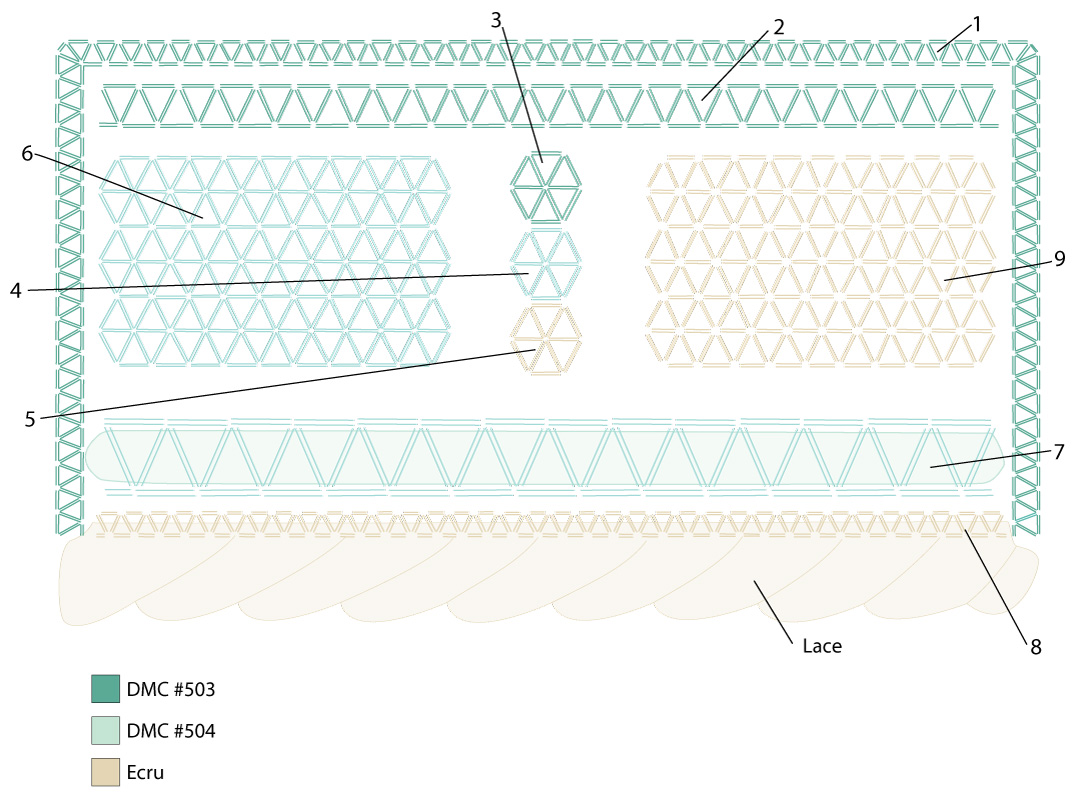The three-sided stitch is a triangular, flat-line stitch, which can also be tightly pulled to create a lacy appearance. It is also known as the Turkish, Bermuda faggoting, lace, and point Turc stitch. The notable French author Thèrése de Dillmont illustrated but didn't name this stitch in her 1878 book Encyclopedia of Needlework in the chapter “Embroidery on White Materials.”
Above: The sample was designed and stitched by Deanna Hall West. Design size: 4½ x 2¾ inches (11.4 x 7.0 cm). Materials: Wichelt Linen, 32-count, Ivory; DMC Pearl Cotton, size 12, #503 and #504, 1 ball each; DMC Embroidery Floss, 6-stranded, #503, 1 skein; John James Needles, tapestry size 22 or chenille size 22; satin ribbon ¼ inch (6 mm) wide, Ivory; Cluny-type lace ⅜ inch (9 mm) wide with both edges finished, Ivory; sewing thread, Ivory, for basting lace and ribbon ends; and a magnifying glass, if needed. Center the design in the hoop and stitch, following the pattern and key below.
This old stitch can be worked on plain as well as evenweave fabrics. However, when stitching on plain fabrics, it's important to carefully work the three legs as evenly as possible to produce an equilateral triangle. The easier nonpulled variation is often used on fine lingerie materials and creates a decorative design pattern. It’s also used to apply lace, ribbon, or other decorative materials to a base fabric. The terms Bermuda faggoting and lace stitch refer to the three-sided stitch only when the stitch sews down a narrow hem or when joining together two lightweight fabrics.








Illustrations by Ann Swanson.
Traditionally, the three-sided stitch is worked right to left with each leg sewn twice before proceeding to the next leg (Figure 1) and keeping the doubled threads as parallel as possible. However, I have seen the stitch illustrated and worked with only one stitch per leg (Figure 2) and worked left to right (Figure 3), too. The doubling and pulling each leg individually with a tight tension easily creates the appearance of lace. Either a tapestry or sharps needle, depending upon the ground fabric, is used, but usually one with a wider than normal diameter is preferred. The wider needle size aids in the creation of a larger hole at each corner of the stitch. When stitching multiple rows stacked upon each other with the corner holes aligned for a solidly filled background, only the very top and bottom horizontal rows need to be stitched twice because the succeeding rows supply the second horizontal leg (Figure 4).
One can work this stitch over almost any number of fabric threads, but normally four, five, or six threads (Figures 1 and 2) are enclosed. For the nonpulled variation, almost any type of thread can be employed, but a sturdy thread—pearl cotton, tatting or crochet threads, coton à broder, cordonnet, and even a fine but strong sewing thread—is needed for the pulled variation. Variegated and overdyed threads create an especially dynamic visual effect. The three-sided stitch doesn't necessarily need to follow the grain of the fabric, so it can be used for gently scrolling designs and even for a circular hem by compensating each triangular stitch just a little to achieve these nonstraight lines.
This versatile stitch can be used as a solitary motif (Figure 5); band; border (Figure 6); outline; allover filling (Figure 4); hemming; attaching or couching down additional elements, such as lace and ribbon, to the ground fabric (Figure 7); and as a decorative join for two fabrics as the surplus fabric can be closely trimmed away to create a flat, nonabrasive seam. The three-sided stitch has been and is still used on samplers, lingerie adornment and construction, whitework, and various pulled and drawn work (Figure 8), as well as other types of embroideries.
Three-Sided Stitch Sampler Legend
 Notes: When stitching with multiple strands or when stitching each leg twice, keep the individual strands as parallel as possible for the best appearance. Follow the design legend for thread type and color placement. Stitch each leg of the three-sided stitch twice, except for when floss is used. Allow 4 to 5 background threads, if possible, between each design element.
Notes: When stitching with multiple strands or when stitching each leg twice, keep the individual strands as parallel as possible for the best appearance. Follow the design legend for thread type and color placement. Stitch each leg of the three-sided stitch twice, except for when floss is used. Allow 4 to 5 background threads, if possible, between each design element.
Stitch in the following order:
- #503 pearl cotton pulled tightly over 4 x 4 threads.
- #503 floss, using all six strands, not pulled, over 6 x 6 threads.
- #503 pearl cotton not pulled over 6 x 6 threads.
- #504 pearl cotton not pulled over 6 x 6 threads.
- Ecru pearl cotton not pulled over 6 x 6 threads.
- #504 pearl cotton background filling and not pulled over 6 x 6 threads.
- #504 pearl cotton ribbon couching and not pulled over 10 x 10 threads.
- Ecru pearl cotton pulled tightly over 4 x 4 threads.
- Ecru pearl cotton background filling and pulled moderately tight over 6 x 6 threads.
—Deanna Hall West
Deanna Hall West is PieceWork’s needlework technical editor; she previously was the editor of The Needleworker magazine. Stay tuned for more stitch tutorials from Deanna in the months ahead!
Enjoy learning more about embroidery stitches in our eBook.
Featured Image: Photo by Matt Graves.

